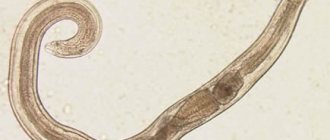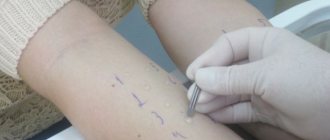Toxocariasis
is a disease caused by helminths of the nematode group (roundworms). The symptoms are very extensive, as they depend on which organs the larvae have entered. In the acute period, the signs of the disease are similar to those of other helminthiases.
Toxocariasis is quite common in all countries. Most often, it affects children who become infected while playing in the sand and with animals, and adults in the course of their professional activities. The risk group includes veterinarians, dog handlers, agricultural workers, and utility workers.
tests
Definition of disease
Toxocariasis is the migration of animal helminth larvae into the human body. The source of the disease, toxocara, was discovered by the German scientist Werner in 1782. Only in 1950 was infection by these helminths identified as a separate disease. Toxocara eggs can be found in soil and contaminated water. The main carriers are dogs, cats, other domestic and wild animals.
Since almost all invasions are characterized by a long course in most cases with mild manifestations, it can be argued that almost 90% of the population are infected or have been infected at different times. According to WHO research, helminthiasis ranks 4th in the world ranking in terms of the degree of damage to human health.
What do Toxocara look like in feces?
Both adult helminths and eggs can be excreted in feces. Toxocara eggs are microscopic, and they are colored brown (not by feces, but by their pigment). For these reasons, it is impossible to detect eggs in feces with the naked eye.
Toxocara eggs have a round shape, size - 65-75 microns. The outer shell is thick and sticky, allowing it to adhere to surfaces. And in the photo - adults.
You can see sexually mature individuals, and the sight is terrifying. Adult toxocaras are 4-18 cm long. Growing ones are much smaller, but they can also be seen: they look like oblong white dots.
A distinctive feature of Toxocara from other similar helminths is its signature head - swellings of the cuticle form small lateral wings. However, they cannot always be seen with the naked eye. The author of the article saw them only in the largest individual. If you don't see the "hood", you may confuse Toxocara with other types of helminths.
Toxocars adults: photo
Causes of toxocariasis
Infection with toxocariasis occurs when Toxocara eggs enter the human body with food and water, through household, contact, and fecal-oral routes. Infection is possible through contact with animals, especially homeless ones, and soil contaminated with eggs. The most common sources of infection are puppies, pregnant and lactating bitches. Cockroaches contribute to the spread of toxocariasis in everyday life; they absorb helminth eggs and subsequently release some of the living individuals.
There are currently 2 types of parasites known:
- T. canis - parasitic in animals of the canine family (dogs, wolves, arctic foxes, foxes);
- T. mystax are parasitic on animals of the cat family (cats, lynxes, panthers, lions).
Humans are not a natural host for the parasite. Therefore, most of the Toxocara die in the human body due to unsuitable conditions for survival. They do not reach sexual maturity. Humans are a dead-end branch; it is impossible to become infected from other people.
Varieties of Toxocara
Toxocores are helminths of the order Ascaris. These organisms come in several varieties:
- Toxocara canis (toxocara canis) - toxocara of dogs;
- Toxocara cati (Toxocara cati), second name - Toxocara mystax (Toxocara mustax) - toxocara cats, toxocara feline;
- Toxocara vitulorum (cattle toxocara);
- Toxocara leonina (common toxocara for cats, dogs and humans);
- and others, less common.
Different types of Toxocara parasitize different types of animals, i.e. canine Toxocara canis does not affect cats, and Toxocara cati does not affect dogs. Even within the same species (for example, Toxascaris leonina), different strains behave differently: canine Toxascaris leonina only infects dogs, but feline Toxascaris leonina can infect dogs too. However, infestation with the Toxascaris leonina species does not cause toxocariasis, but toxascariasis, which, unlike toxocariasis, never occurs in puppies and kittens and always affects only adults.
Pathogenesis
The causative agent of toxocariasis is roundworms of the Nematoda class. Two species of Toxocara have been discovered; T. canis, parasites of the canine family, can be found in humans. The likelihood of infection with T. mystax has not been established. The pathogen enters the human body in the egg phase with a living larva (cyst), with an average size of 60 microns.
In the digestive tract, the shell of the eggs disintegrates. If a person’s immunity is weakened, the larvae (larvae) become active and begin their migration. Through the bloodstream they penetrate into various tissues, systems and organs. The next stage is the formation of lesions: inflammation, hemorrhage, necrosis. The antigenic effect of larvae leads to allergic reactions.
Granulomas form in the areas where the larvae invade. They are surrounded by fibrous tissue, as a result they cannot receive more nutrients and die. However, in such a short life, the larvae manage to have a significant negative impact on the liver, lymph nodes, lungs, myocardium, and brain. This can lead to the development of pneumonia, pancreatitis, respiratory failure, cause hepatitis or meningitis. Infestations can lead to partial or complete loss of vision and other diseases.
Maturation of Toxocara eggs
The ideal environment for the development of eggs is moist (20%) soil with a temperature of +23 +30 degrees Celsius. Under such conditions, the larva develops in the egg within 5-8 days, that is, very quickly. At +25 degrees, the egg matures in 15 days. If the temperature is +15 +18 degrees, the process slows down significantly - up to 36 days. At temperatures below +10 +13 degrees, larvae do not develop in eggs. At temperatures above +40 degrees, the eggs die within a week. The minimum humidity of the nutrient medium for egg maturation is 5-8%.
If you pour boiling water over the eggs, they die in a few minutes. In addition, they cannot ripen in complete darkness, but direct sunlight, drying them out, destroys them. At the same time, an egg can overwinter under the snow, and then become a “tasty morsel” for someone when it ripens in the spring. Ripe eggs also live long before they find a host.
But what about the apartment? If there is a kitten or puppy at home that is releasing eggs, can larvae develop? In apartment conditions, Toxocara eggs can also mature, because temperature, and sometimes humidity, favor this. However, the eggs need to sit in a suitable environment, such as soil, sand or feces, and where in the apartment is something like that not cleaned for weeks? Toxocara eggs do not mature in animal fur and dry out quickly.
However, below we will talk about how not to give a chance to even ripe eggs brought into the house from the street on shoes and on the paws of an animal.
Classification
In the international classification, toxocariasis is assigned the code B83.0.
The disease is classified according to the following characteristics:
Type of disease development and severity of symptoms:
- Typical form.
- Atypical form (asymptomatic, with erased symptoms).
Form of defeat:
- visceral,
- ophthalmic,
- cutaneous,
- neurological,
- muscles affected
- the thyroid gland is affected,
- lymph nodes are affected.
Severity of illness:
- light;
- medium-heavy;
- severe form.
Nature of the disease:
- Smooth,
- Unsmooth (with complications, exacerbation of existing diseases).
Duration:
- Acute (up to 3 months from the moment of infection).
- Chronic, lasting more than 3 months.
Visceral form
The most common form of toxocariasis is visceral, diagnosed in 90% of cases. Characterized by low-grade fever, intoxication syndrome, and decreased appetite. More than half of patients have a nighttime, unproductive cough. The invasion is accompanied by disturbances in the gastrointestinal tract, including flatulence, diarrhea, and vomiting.
Ophthalmic toxocariasis
The ocular form is the second most frequently diagnosed, but still quite rare. Granulomas are found in the posterior and peripheral parts of the eyeball. This leads to inflammation of the choroid, vitreous abscesses, inflammation of the optic nerve and other abnormalities caused by the migration of larvae. As a rule, only one eye is affected; double damage is extremely rare. Ophthalmic toxocariasis leads to decreased vision, strabismus, and the formation of a dull (opaque) white lump (leukocoria).
Neurological form
Characterized by convulsions, paralysis, behavior disorder, muscle movement disorders, muscle pain. The neurological form is extremely rare and leads to meningitis or meningoencephalitis.
Damage to the thyroid gland
Symptoms of larvae penetration into the thyroid tissue are expressed in its enlargement. The lymph nodes in the submandibular and neck area also increase in volume. The liver and spleen are affected. Lymph nodes are painful when palpated, but no inflammatory changes occur.
Routes of infection
Toxocariasis in dogs can be transmitted as follows:
- parasite larvae can be transmitted to puppies before birth;
- through mother's milk to puppies;
- If the dog has ever had these worms and been treated, she may still be carrying dormant larvae in her body tissues. Dormant larvae can revive and be transmitted to the young;
- by ingesting feces or soil that is infested with larvae;
- if an individual eats an infected animal (rat, mouse, bird, infected cattle waste);
- Cockroaches and earthworms can also carry the disease if they enter a dog's internal organs.
Symptoms
The clinical picture of toxocariasis is varied, since the symptoms are directly related to the affected organs. The following symptoms are common to all forms of the disease:
- Temperature with chills from subfebrile in mild cases to +39 C, can last up to 3 weeks.
- Headaches of moderate intensity.
- Intoxication syndrome: loss of appetite, nausea, non-localized abdominal pain, diarrhea.
- Significant increase in the size of lymph nodes, liver, spleen.
- Respiratory syndrome: from mild night cough to bronchial obstruction, pneumonia, signs of suffocation, cyanosis.
- Skin syndrome, expressed in allergic reactions, urticaria, papular rashes. More often they appear on the skin of the lumbar region and extremities.
In the acute form of central nervous system damage, headaches, insomnia, and convulsions are observed. The pathological condition can lead to meningoencephalitis, myelitis, arachnoiditis, paresis and paralysis. In some cases, mental disorders are observed. Patients with ocular toxocariasis complain of deterioration in the quality of vision, the appearance of passing “dots” in front of the eyes and a blind spot that does not pass.
Symptoms are recurrent, on average they appear for 1 - 3 weeks, then go away, and after some time they make themselves felt again.
Diagnostics
Diagnosis of toxocariasis is carried out by an infectious disease specialist. It is necessary to interview the patient to identify the route of infection. Are there dogs in the house, have you had contact with stray animals? Is it possible to accept the possibility of consuming foods and water containing Toxocara eggs?
Laboratory diagnostics include the following methods:
- Biochemical - confirmation of nosology by detecting increased IgE antibodies, decreased albumin levels, hypergammaglobulinemia. A study can also be conducted to determine changes in the data of the hepatic and pancreatic complex.
- The serological ELISA method also allows you to confirm the diagnosis.
- Hematological - aimed at identifying the growth of eosinophils, an increase in leukocytes, a decrease in hemoglobin levels, and an increase in ESR. The method allows you to determine the severity of the disease.
- Sputum microscopy is used to identify the form of the disease.
To clarify the clinical form of toxocariasis and determine the severity of the disease, instrumental studies are prescribed:
- X-ray;
- Ultrasound of the peritoneum;
- external respiration testing.
Electrocardiography, computer and magnetic resonance imaging are performed. Also, if necessary, the reactivity of the bronchi can be studied, and ophthalmological, neurological and histomorphological studies of the affected organs and tissues can be performed.
Toxocariasis of the eye
If ophthalmic toxocariasis is suspected, an ophthalmological examination is performed. Its goal is to identify Toxocara larvae in the macula, optic nerve area, and vitreous body. Sometimes during examination you can record the movements of the parasite. The examination reveals not only the larvae themselves, but the degree of changes that have occurred: hemorrhages, fibrosis, retinal detachment.
Criteria for confirming the diagnosis
- Sort by diagnostic power score from highest to lowest:
- Eosinophilia in peripheral blood.
- Increases in total protein and IgE with a decrease in albumin volume.
- Detection of IgG antibodies in a titer of 1:800.
- An increase in ESR with a decrease in the level of hemoglobin and red blood cells.
- Detection of increased levels of liver transferases, alkaline phosphatase, and direct bilirubin amylase in the blood serum.
- Detection of increased amylase levels in urine.
- Detection of Toxocara larvae in sputum.
These data also help determine the severity of the disease. For example, high leukocytosis indicates the presence of complications along with severe eosinophilia and increased amylase in the urine.
The tasks of an infectious disease doctor also include differential diagnosis. First of all, it is necessary to exclude ascariasis, opisthorchiasis, and strongyloidiasis. If ophthalmic toxocariasis is suspected, it is necessary to exclude retinoblastoma, and allergic skin rashes from a reaction to allergens and insect bites.
Blood ELISA for igg antibodies: positive, negative and what it means
Among serological tests, ELISA is considered the most reliable, since it can be used to determine whether there are antibodies in the blood to the antigens of certain parasites. A positive result is if the igg titer is above 1:200; values from 1:200 to 1:400 indicate the presence of toxocara in the body, and antibody titers above 1:600 indicate the development of the disease and the need for urgent treatment.
ELISA is a very reliable method (up to 95%), and its price is not so high - from 300-350 in regional centers to 550-600 in Moscow and St. Petersburg.
Treatment
Therapy for toxocariasis can be carried out in a hospital or on an outpatient basis, depending on the nature and severity of the disease. Patients with manifest and atypical forms are subject to mandatory hospitalization, in the presence of complications. The activities are aimed at achieving the following tasks:
- stopping the development of pathology;
- prevention of complications;
- preventing the formation of residual and recurrent phenomena.
The treatment method depends on the clinical picture. First of all, anthelmintic drugs are prescribed to stop the migration of larvae.
For the purpose of detoxification, solutions consisting of potassium, magnesium, calcium, sodium, sodium acetate chlorides and containing dextrose are administered. Potassium and sodium chloride also helps restore electrolyte balance.
Healing is the complete disappearance of symptoms, a decrease in the level of antibodies and eosinophils in the blood, and the absence of signs of damage to other organs. Dispensary observation is recommended once every 2 months for a year. Children are seen by a pediatrician, adults by a general practitioner, family doctor, or infectious disease specialist. The list of laboratory tests used during the observation period includes a clinical blood test, coprological studies, and others, depending on the affected organs.
How to make a diagnosis?
In humans, the development of intestinal forms of toxocariasis does not occur, with rare exceptions. Therefore, it is impossible to detect the parasite in feces. But for dogs and cats, one of the main tests is carried out a coprogram - a stool test for toxocariasis, during which they look for eggs and adults. But this method has a large error, because There may be nothing in a specific portion of feces. Therefore, to get the correct result, feces must be taken several times.
An indirect indicator of toxocariasis is the presence of IgG and IgE antibodies in the blood against this parasite. Such tests are performed on both animals and humans. Antibodies to Toxocara are produced by the immune system of mammals in response to the entry of a helminth into the body. You need to understand that a blood test for toxocara only determines the presence of antibodies, and not the parasites themselves in the body. Thus, this is only an indirect sign and is not sufficient to make a diagnosis.
Article continues after advertisement
In addition, for people, a characteristic indicator of the presence of toxocara is an increased content of eosinophils and leukocytes in the blood, accelerated ESR, and hypergammaglobulinemia. However, these indicators can also change in other diseases, so differential diagnosis with other pathologies is required.
The final diagnosis is rarely made - it is made by the presence of granulomas with larvae in the tissues. To do this, a biopsy is taken from the organs. But the procedure is complex, sometimes dangerous and cannot always be objective, because the larvae still need to be found. Therefore, the diagnosis is most often made based on blood tests and symptoms.
Although the disease is difficult to treat and success may not be noticeable immediately, the prognosis for life and health is still favorable. However, in rare cases, if severe organ damage is present, even death is possible.
Complications
Among the most common complications after suffering toxocariasis are:
- asthma of bronchitis type;
- Chronical bronchitis;
- epilepsy;
- retinal detachment;
- one-sided blindness.
In the acute phase of the disease, larvae located subcutaneously can cause the formation of infiltrates, abscesses, and phlegmons. Due to weakened immunity, a bacterial infection may occur. Damage to the lungs is dangerous, which causes the development of pneumonia, respiratory failure, which, if unfavorable, can cause death.
The degree of development of complications depends not only on which organs are affected, but also on the number of larvae. Extensive parasite infestations cause multiple organ failure. The patient requires urgent resuscitation care and the risk of death is high.
If infection occurs in a pregnant woman, there is a high probability of damage to the fetus. Toxocariasis leads to miscarriages, premature births and various intrauterine growth retardations.
Prognosis and prevention
For mild and moderate forms of toxocariasis, the prognosis is favorable. Complete recovery without complications is observed in 90% of patients. In 5%, the development of iatrogenic complications is observed, in 5% new diseases caused by toxocariasis develop, and relapses are noted.
Prevention consists of carrying out general sanitary measures to protect the environment. First of all, it is necessary to create special walking areas for dogs. Feces must be disposed of and not left on the ground. Also, dog owners must undergo regular deworming, and street stray animals must be caught.
Particular attention should be paid to hygiene. It is necessary to wash your hands thoroughly after returning home and avoid contact with other people's animals. You cannot eat food on the street if you cannot wash or sanitize your hands. Vegetables and fruits should be well washed. Children need to be taught hygiene skills from childhood. While playing in the sandbox, it is important to prevent sand and soil from being eaten; afterward, it is equally important to wash the baby.
If there is a sick person in the house, all family members must be examined. The premises should be disinfected and individual, disposable care products should be provided to the patient.
Preventive actions
In recent years, every case of toxocariasis has been registered with the SES. Prevention of toxocariasis comes down to the following. One of the main activities is the examination of dogs and their timely deworming. Equally important is the limitation of special areas for their walking and maintenance of these areas in proper hygienic condition. It is still important to observe the rules of personal hygiene: washing hands after contact with soil or contact with animals, careful handling of greens, vegetables, and food products that may contain soil particles. And in the USA they even issued a postage stamp containing information about the need to immediately clean up dog feces in order to reduce the incidence of toxocariasis.
Infectious disease doctor-gastroenterologist Pugaeva S.V.
Advantages of JSC "SZTsDM"
You can take tests to identify Toxocara larvae in one of the laboratories of the SZTsDM. You can undergo a full examination in the comfortable conditions of the center:
with the latest diagnostic equipment;
with qualified, friendly employees;
without queues, with the possibility of a specialist visiting your home.
The laboratories are located in places with convenient transport accessibility in Pskov, Veliky Novgorod, Kaliningrad, St. Petersburg and other cities of the Leningrad region. Regardless of where the tests are taken, you are guaranteed quick availability of results, which can be obtained in several ways.
For more detailed information, please contact our managers by phone.








